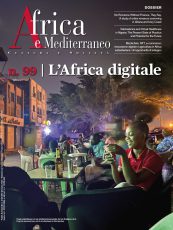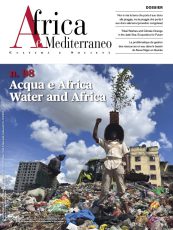L’Africa digitale | Digital Africa
Africa e Mediterraneo n. 99 (2/23)
Digital Africa
This digital revolution is an undeniable reality but not a homogeneous one worldwide. Access (or lack thereof) to digital technologies is counted among the factors of social in/equality, alongside class, gender, sexual preferences, and age. Africa e Mediterraneo’s latest issue examines some intrinsic dynamics of digitization in Africa, providing insights into the challenges and achievements faced by governments, businesses, and individuals in highly receptive yet infrastructurally complex contexts. This continent encounters unique opportunities while adapting to rapid technological, economic, social, and cultural innovations. The advancement of digitization across the fifty-four countries is a litmus test that can tell us much about the continent’s future and global positioning.
Data confirms that Africa as a whole is at the forefront of digitization, yet as a more volatile context compared to the global North, where transition factors and dynamics are already consolidated. This is due to a varied scenario, marked by profound differences in the penetration of infrastructure and digital literacy, reflecting disparities between regions and between urban centers, peripheries, and rural areas. Overall, there is a delay in infrastructure development and ICT literacy, primarily reliant on individual or private initiatives, a delay more pronounced in certain regions, especially central ones, and less pronounced along the eastern coast and in southern Africa. Additionally, most governments show limited responsiveness in approving policies supporting digital transition, investing in human capital, and providing social protection for workers exposed to occupational fluctuations associated with the increasing use of digital production tools. Simultaneously, the digital economy is growing dynamically and in a widespread fashion, driven by young entrepreneurs adapting development and innovation processes born elsewhere to the needs of their local contexts. Armed with digital and hard science knowledge – technology, mathematics, and engineering – these actors lead a global movement of young and competitive African innovators.
The percentage of Internet users shows significant differences across regions but records strong growth trends almost everywhere. According to a January 2023 ITU survey, the percentage of connected users in the total population of the continent was: 65.9% in North Africa, 27.9% in Central Africa, 48% in West Africa, and 70.6% in Southern Africa (ITU/UN 2023). Social media is widely used, with platforms like Facebook, X (formerly Twitter), and WhatsApp playing a crucial role in economic growth, business, public debate, and mobilization. In Africa, mobile devices are the primary means of accessing social media. A recent GeoPoll survey (September 2023) revealed that the average daily usage time of these platforms is between 3 and 6 hours. Facebook emerges as the dominant platform, with 82% of active users, mainly used for keeping in touch with friends and family, staying informed, and making new connections. TikTok follows with a 60% active user rate, popular for viewing and sharing short videos, entertainment, acquiring new skills, and discovering helpful hacks. Instagram attracts 54% of users, focusing on exploring creative content, the lives of influencers and celebrities, and actively sharing photos and visual memories. This individual use of digital media has multiple implications and effectively guides the digital revolution practically everywhere in Africa. Literature on the spread and uses of social media demonstrates a positive correlation both with economic growth and individual engagement. Overall, digital technologies are found to reduce launch times and business costs, improve productivity and efficiency, facilitate access to information and consumers. In particular, start-ups and small and medium enterprises active on social networks experience increased visibility and market reach, online sales, and marketing. For individuals, social media represents a tool for participating in collective life, in some cases personal growth, and certainly, they are essential for socialization and communication.
Despite the considerable potential of digital technologies, the disparity in access to infrastructure is, as mentioned, an obstacle for rural communities excluded from the digital transition, unlike a large part of urban areas benefiting from infrastructure and connectivity. This disparity creates a gap that limits access to information, economic opportunities, and many services. However, when present and used, digital media also offer unprecedented opportunities to improve efficiency and quality of life, with the spread of smartphones and Internet access driving the democratization of information and a widespread improvement in living and working conditions.
Cover: At the maki in Adjamé, Ivory Coast, 2023. Photo by Valentina Peri
Africa e Mediterraneo n. 99 (2/23); Lingua: Contiene articoli in italiano e inglese; Codice ISSN: 1121-8495; Formato: 100 pp., 21×28 cm, brossura filo refe.
SOMMARIO







